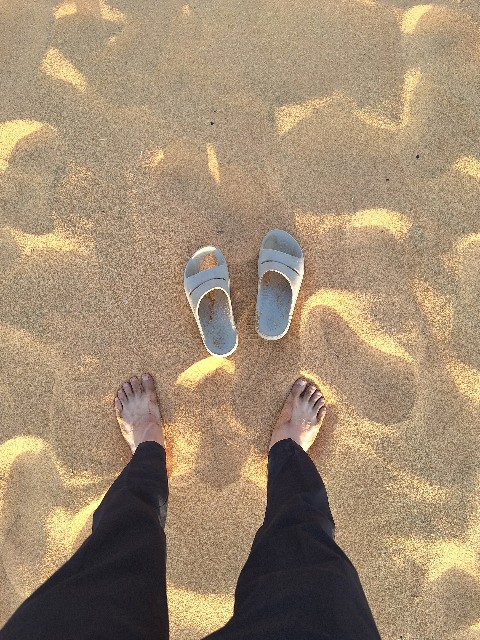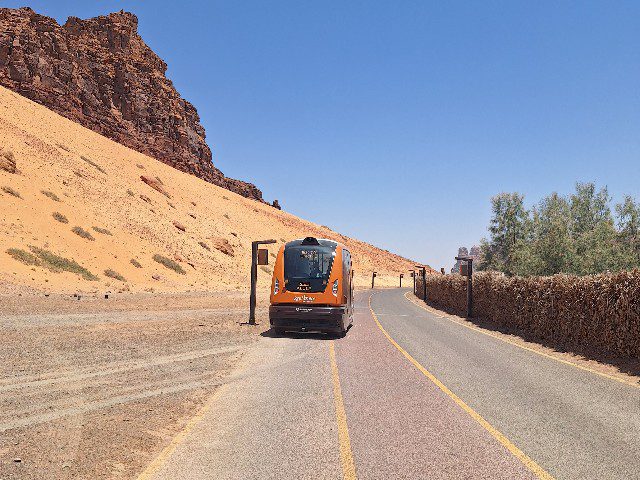
After completing our tour of Jabal Al-Banat, the bus takes us to the main dish of the Hegra ruins complex – the famous massive tomb structure featured in many tourist photos and postcards. Today, I’ll focus on our visit to the Tomb of Lihyan, son of Kuza, and Jabal Al-Ahmar.
Tomb of Lihyan, Son of Kuza – Meeting the “Lonely Castle”

As the famous ruins come into view, everyone’s Indiana Jones spirit rises
Finally, we stand before the Tomb of Lihyan son of Kuza, also known as “Qasr Al-Farid (The Lonely Castle).” Built in the 1st century CE, this tomb is particularly significant among the ruins that were designated as Saudi Arabia’s first UNESCO World Heritage Site due to its exceptional design and architectural technique.

Comparing it to humans makes its enormous size easier to understand
The nickname “castle” might actually be somewhat misleading. This is a magnificent mausoleum, and the inscriptions and carvings inside teach us much about ancient Nabataean culture. The facade features four massive carved columns, each with intricate decorations at the capitals. The stepped decorations at the top are particularly characteristic designs also found in other Nabataean architecture like Petra.

The construction technique is also distinctive, employing the uniquely Nabataean method of carving from top to bottom. Scaffolding was first set up at the top of the rocky mountain, from which craftsmen gradually carved their way down. This speaks to the high level of architectural technology of the time, and understanding this process deepens our comprehension of why the lower portion remains unfinished.
As the sun began to set, the shadows created by the sunset streaming from the side highlighted every detail of the tomb’s surface through the interplay of the relief. The shadows between the columns particularly gave the entire structure a three-dimensional quality, making its grandeur even more striking.
View from the Sand Dune

While listening to the guide’s explanation, I was driven by the desire to capture the full scope of this magnificent sight and decided to climb a nearby sand dune. The fine sand on the steep slope kept crumbling, making it difficult to ascend. Eventually, I took off my sandals and attempted the climb barefoot. Desert sand is fascinating – while the surface is warm, the interior feels pleasantly cool.

By examining the full structure, I could understand the truth behind the story that this magnificent tomb was actually unfinished. Looking at the lower portion, I could clearly confirm that the precision of the carving is indeed somewhat inferior compared to the upper section. However, even this can be seen as part of the building’s charm. What was the reason it was never completed? Perhaps pondering such questions is part of the joy of experiencing history firsthand.

Looking down from the premium seat on the sand dune with a staff member
One of the Saudi staff members from the guide team called out, “You can see it better from over here.” From the spot they showed me, I could get a panoramic view of the tomb illuminated by the western sun, and it was also an excellent photo spot where other participants wouldn’t appear in the frame. Moving away from the group slightly, I continued gazing at the structure from atop the sand dune for a while.
Jabal Al-Ahmar at Sunset

Our final destination, Jabal Al-Ahmar, is sometimes skipped due to time constraints. Fortunately, we had enough time this day to visit it. The sun was about to set beyond the horizon, and I could sense that darkness would fall quickly.

To the very last ruins of the day
The participants, perhaps already satisfied with Lihyan’s tomb, walked somewhat tiredly in a line in front of the ruins. However, this site preserves 18 tombs and is an important archaeological complex where new discoveries continue to be made in recent years. I myself was more captivated by the surrounding canyons glowing golden in the sunset and the distant view of Lihyan’s tomb than by the Ahmar ruins themselves. This was truly AlUla’s golden hour.

In the distance, Lihyan’s tomb turns orange in the sunset
The tomb of Hinat, a Nabataean woman from 2,000 years ago, is particularly famous here. From this tomb, numerous valuable artifacts that provide clues about life in that era have been excavated. Daily items such as textiles and leather goods have been preserved in remarkably good condition thanks to the dry desert climate, and these artifacts reveal that the Nabataeans had built a rich living culture in the harsh desert environment.
Contemplating in the Desert Sunset

While the tour started with sweat-inducing heat, the desert was now enveloped in pleasant coolness. I had a chance to chat with a local Saudi, who told me, “When I want to zone out or think about things, I come to the desert.” The coolness and silence of the desert calm the mind, he said. Perhaps it’s like going to a riverside in Japan. I experienced a bit of this Saudi-style chill-out myself.
Calls to return to the bus could be heard from a distance – it was reluctantly time for the tour to end. Upon returning to South Gate, those heading to Winter Park continued on the bus. I parted ways here, but was able to see off the sunset as it disappeared behind the western mountains.

The sunset setting behind AlUla’s western mountains is the climax of today’s tour
Conclusion
The guide’s words, “There are lessons to be learned from the ruins of past civilizations,” are deeply etched in my heart. These ruins continue to speak to us after 2,000 years. The traces of ancient civilization illuminated by the sunset will surely be deeply impressed in the hearts of all who visit.
Only a few years have passed since Saudi Arabia opened its doors to the world as a tourist destination. As I’ve shared through this three-part archaeological exploration, Hegra has achieved a balance between tourism and preservation, maintaining its historical value under thorough protection and management. From heat precautions to reservation systems, thorough preparation is necessary, but the encounter with traces of ancient civilization illuminated by the sunset will surely be an experience worth all the effort. If you’re interested in Arab and Nabataean culture, please visit AlUla and Hegra.



![Exploring Medina’s Sacred Ghars Well Water: Flavor, Quality, and Usage Tips [Saudi Arabia Travel Blog]](https://en.kosupatravel.com/wp-content/uploads/2025/04/20240802131932.jpg)
![Tasting Mandi Head Meat in Jeddah’s Al Balad: A Traditional Local Meal at Baissa Mandi Meat [Saudi Arabia Food Travel]](https://en.kosupatravel.com/wp-content/uploads/2025/04/20240725102840.jpg)
![Is It Realistic to Travel Arabia in 50°C Summer Heat? I Tested It by Walking in the Blazing Sun [Heatwave Travel Experience]](https://en.kosupatravel.com/wp-content/uploads/2025/04/20240804223118.jpg)